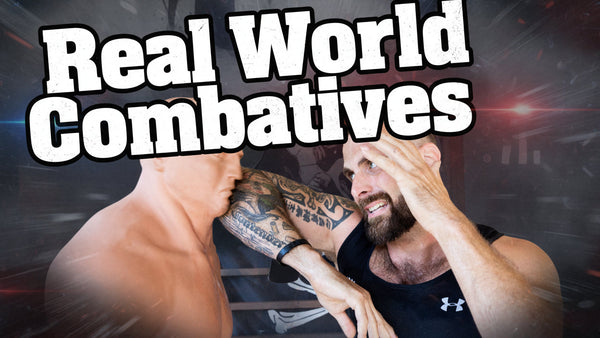Hand to Hand Combat You Can't Learn in the Military
I’m not a veteran. I’m not law enforcement. I'm Greg Tambone, a guy who learned the hard way—through real fights in places where there are no referees, no backup, and no guarantees. Today I’m sharing where my experience comes from, why it’s different than what most people picture, and what actually kept me alive when it mattered.
Years ago, I was attacked by a group of Marines in a bar. I didn’t start it. I probably should have tried harder to de-escalate, but I was young and dumb and enjoyed giving free attitude adjustments to those who needed them most in those days. When they closed in, I defended myself. It got ugly fast. I allegedly protected my head, managed distance, utilized highly efficient striking techniques, and did what I had to do to survive. The scene afterward looked so bad that I was the one arrested. I ended what they started in a few short minutes. Total devastation, blood everywhere, several Marines nearly died... one is permanently disfigured. Later, the charges were dropped. Self-defense can look “gruesome” to bystanders who only see the aftermath—because real violence is fast, messy, and nothing like a choreographed demo. That night taught me that survival isn’t about style points. It’s about ending the threat and walking away.
People assume “military combatives” equals the pinnacle of hand-to-hand fighting. Respect to the military—but context matters. Soldiers usually operate with teams, comms, long guns, sidearms, body armor, air support, rules of engagement, and mission objectives. In the real world—alone—you have none of that. It’s you, your awareness, and whatever you can use in the moment. Most service members will tell you: if they ever end up truly empty-handed, everything else has already gone catastrophically wrong. My training ground has been that empty-handed moment, over and over. And worse than that, sometimes it has been me... alone... in some of the world's most dangerous places. Occasionally in countries where I didn't even speak the language, and often with large, organized elements looking to take me out...
I learned the hardest lessons in lockups and non-permissive environments. In a Florida jail, I got jumped by multiple gang members who didn’t want a fair fight—they wanted me gone. You don’t get to pick the terrain, the lighting, or the number of attackers. There’s no tap-out. Grappling on concrete while others kick your head is a death wish. You learn fast that controlling one guy while his friends circle is losing. You need mobility, frames, violent bursts, and you need to stand back up quickly if you get knocked down. I learned that the first man is an example, what you do to him is how you set the tone. Momentum.
I’m also a martial artist. I’ve fought and competed in the ring. I’ve worked as a bouncer in dozens of bars across America. All of that taught me valuable skills—but the street and the cellblock rewired my priorities. Too many people confuse pain compliance with control. In gyms, joint locks, pressure points, and submissions look clean. In reality, some opponents don’t feel pain the way you expect—because they’re enraged, mentally unwell, trained to ignore pain, or fueled by chemicals. If your plan depends on them “respecting the pain,” you don’t have a plan.
Look around the world and you’ll find fighters who chew or take stimulants and fight for hours. In some conflicts, opponents under stimulants showed extreme pain tolerance. That forced professionals to adapt their tactics because pain alone didn’t stop the threat. The lesson is simple: don’t build your survival on the hope that the other guy cares how much something hurts.
Striking matters. Not wild haymakers—purposeful, high-percentage, structurally sound strikes that end momentum. Muay Thai taught me the value of elbows and knees in tight spaces. They’re short, brutal, and remove the likelihood of breaking your own hand. I’ve seen more “boxer’s fractures” in street fights than I can count. Punching skulls with small bones is a bad trade. Open-hand shots, palms, ridge hand, knife hand, elbows, knees, head butts, and movement… those are tools that survive concrete, chaos, and multiple attackers.
Here’s another reality check: most fights start closer, and end faster than you think. Clothing grabs. Wall pins. Slippery floors. Uneven ground. Environmental weapons. That’s where clinch literacy matters—but not intentionally going to the ground or trying for submissions, that's beyond foolish in the real world. Done right, it's reading timing and controlling distance to make space for decisive strikes and an exit. If you get fixated on “winning” a technical exchange, you can lose the fight. Your goal is not to win a tournament… it’s to break contact, stay on your feet, and live to fight another day with as little damage received as possible.
My experience is the innovation behind the tools I design. Force multipliers matter when your body is fatigued, injured, or outnumbered. That’s part of why I developed compact self-defense tools like the Bone Breaker keychain and the rest of my NPE lineup—items that are small, intuitive, and help protect your hands while delivering decisive impact. Tools don’t replace skill, awareness, or judgment—but they can keep you from shattering your knuckles on somebody’s skull and give you an edge when every hit counts.
I’ve spent years pressure-testing what’s real versus what just looks good. Here are some hard-earned truths:
If your whole plan is pain compliance, you don’t have a plan.
If your whole plan is to go to the ground, you don’t have a plan for friends, blades, or boots.
If your whole plan is punching, you don’t have a plan for your own broken hand.
If your whole plan is complicated, you don’t have a plan for adrenaline, fear, and chaos.
What works consistently? Preemption and awareness. Seeing the storm ten seconds earlier is worth more than ten years of techniques. Position over pride. Managing angles and distance beats arguing or posturing. Simple, repeatable mechanics. Palms, elbows, knees, head control, frames, and footwork you can hit when you’re exhausted. Standing back up. Back to a wall. Protect your head. If you fall, get up. If they grab, strike, and move. Leave when you can. Live to see your family. The best fight is the one you don’t have.
Back to that night with the Marines. What looked “gruesome” was simply me refusing to be a victim. I didn’t try to “win a bar fight.” I did what I had to do to get out alive. The legal system either eventually recognized that, or the Marines realized they got what they deserved... But the internet often doesn’t realize. That’s fine. The haters may never be in our physical presence, safe behind their keyboards for now. But I’m not here to win arguments; I’m here to share what kept me breathing.
In jail, when I was jumped by multiple attackers, the same truths surfaced. Balance. Composure. Short strikes. Explosive movement. No one is coming to save you. You save yourself by making smart choices under pressure and using what’s actually available.
I respect the military, and I respect athletes. But I’m not selling fantasy. I’m telling you what worked for me in places where there are no mats and no medals. My background isn’t about a title… it’s about time under pressure, paid for in fear, sweat, blood, and consequence.
And because I know someone will twist this: I don’t glorify violence. My faith and my values push me toward restraint, responsibility, and protecting the innocent. Real self-defense is about humility, discipline, and leaving when you can. But when you can’t leave, you need skills that are simple, robust, and proven where it counts.
So, if you’re evaluating who to learn from, don’t look for the loudest costume or the longest resume. Look for results you can verify and principles that hold up under stress. Ask: Will this work if he has friends? Will this work outside the gym? Will this work because a Navy SEAL said so? Will this work if he doesn’t feel pain? Will this keep me out of jail and out of the hospital?
That’s the filter I’ve used to build my approach, my training, and my tools. I learned it the hardest way possible so you don’t have to. If you want the polished mythology, there are plenty of channels for that. If you want real-world survivability—from bar floors to holding cells to foreign streets—that’s what I teach. Stay humble. Stay aware. Protect your hands. Use your head. And always choose the exit when you can.



